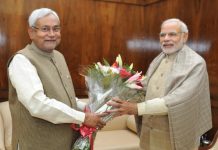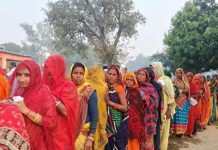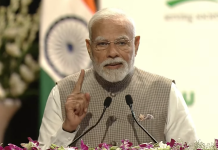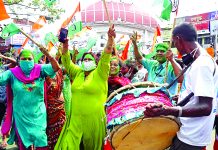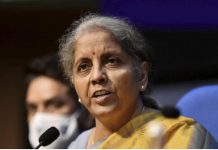While Congress is upbeat after turning it around in the LS poll, the ruling BJP, battling strong anti-incumbency, is ready with a 90-day grueling schedule during which it will do whatever it takes – from announcing welfare plans to holding samadhan shivirs – to woo voters, reports Aayush Goel
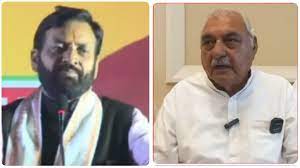
Spurred by recent Lok Sabha elections the political temperature in Haryana is charged up ahead of state assembly polls. The polls slated to be held in October will be an acid test for all parties with the ruling party giving it all for a record third tenure, chance for opposition to reclaim power after a decade, and regional parties fighting for their sustenance in state. From party hopping, padayatras, last-minute announcements of welfare schemes/sops by the ruling BJP, key appointments based on caste equations, pre-poll alliances, and daily exchange of allegations and counter-allegations have blown the poll bugle in the state.
Following muted performance in Lok Sabha elections, the ruling BJP is working hard to plug the holes. Battling a strong anti-incumbency wave in the state, the party is ready with a 90-day schedule announcing welfare schemes and holding ‘samadhan shivirs’, the party is doing all it takes to woo voters. It is trying to balance the caste equation to take on the Congress which has the support of Jat voters, through OBC Chief Minister Nayab Singh Saini, who was appointed just before Lok Sabha elections. Meanwhile having won five out of 10 Lok Sabha seats in state in Lok Sabha elections, Congress oozing with newfound confidence is out playing on the front foot and attacking the government. Party like JJP (Jannayak Janta Party) which was a vital part of state government and was ‘dumped’ right before Lok Sabha elections is trying to keep itself afloat and looking for alliances. The state this time is seeing the formation of a third front as well.
Will the gamble pay off?
Amidst the biggest questions for BJP in these state elections is — will the Lok Sabha pre-poll gamble of changing former CM ML Khattar with Nayab Saini really pay off? Party in a bid to balance out caste equations which are decisive factors in the state made the change. If Saini’s appointment was cited as an attempt to woo OBC voters, the party made similar decisions for caste balancing. On July 9, the BJP named Mohan Lal Badoli, a Brahmin, as its state president. Khattar, a Punjabi, moved into the BJP-led Union Cabinet and was allotted key ministries — Power and Housing and Urban Development. Coming under the OBC category, Sainis are estimated to constitute just about 1 percent of the state’s population. However, various estimates put the OBC or backward class population at 30 percent in Haryana. BJP sources said that for the Rajya Sabha election, likely to be held in late July or early August, the party may field Banto Kataria, who lost in the Lok Sabha polls from the Ambala reserved constituency. Earlier, in April, the BJP sent Subhash Barala, a Jat, and former Haryana BJP President, into the Rajya Sabha.
Nayab Saini, who is under immense pressure to prove himself, is putting in his best efforts. From winning the Karnal by-poll to a whirlwind tour of the state, announcement of welfare schemes, improving response time and addressing day-to-day issues, Saini is out to woo voters and prove a worthy lead for the party. While his appointment as CM is still being debated amongst political circles, the BJP has announced to fight forthcoming assembly elections under his leadership. Even post Lok Sabha election, speculations were rife about yet another change of guard in the state. Union Home Minister Amit Shah made this announcement at the party’s state executive meeting attended by about 4,500 BJP workers.
The declaration, according to many BJP leaders, has already alienated other communities and left prominent leaders disappointed. The choice of Khattar over Rao Inderjit Singh in the union cabinet and alleged cold shouldering of ‘Ahirs’ in prominent positions in party ranks has left the community irate and voicing their concerns. The community vote can impact at least 15 assembly segments in the southern part of Haryana. “We shifted our loyalties from Congress to BJP in 2014 following indifference and lack of importance in the Hooda government. The issue is the same here. Ignorance of Rao Inderjit Singh, a six-time MP, in allotment of cabinet berths and non-consideration of Ahirs for important posts like BJP president or CM really makes us doubt our loyalty. If the party continues to choose the GT road belt over Ahirwal we have to rethink,” said Sandeep Yadav of Yadav Mahasabha.
Rao Inderjit, who has been known for his rebel streak, is not saying much even as his supporters are out screaming that he is the most deserving CM claimant. Rao has given pre-poll jitters to the BJP as he has announced his own pan-state tour program. Not just him, but many other leaders who were denied Lok Sabha tickets or have failed to make it to the state cabinet to date are miffed, hinting that the BJP has to take care of many internal battles before the October polls.
Cong hopes for a comeback
With this assembly election being speculated as the two-time CM and Jat stalwart leader Bhupinder Singh Hooda Congress is out to reclaim the state after a gap of a decade. On July 11, PCC president Udai Bhan, and Congress Legislature Party leader Bhupinder Singh Hooda released the Congress poll campaign plan. They were accompanied by senior Congress leader Birender Singh, who recently returned to the Congress after a decade in the BJP, and newly elected MPs and several MLAs. The party announced that they would be reaching out to every single voter and would be holding a ‘rath yatra’ and ‘padayatra’ across all 90 constituencies of Haryana. “We aim to cover at least two constituencies daily,” Bhan said. While the party is enthused with a five-seat win in Lok Sabha it still is battling factionalism. Many senior leaders have blamed Hooda’s influence on candidate selection for the party not registering a clean sweep in the state. These factions have found a new leader in Kumari Selja, a newly elected MP from Sirsa. She has announced a separate ‘padayatra’ across Haryana’s urban constituencies in the coming weeks. She said she chose these seats as the BJP was ahead of the Congress here in recently concluded Lok Sabha polls.
Another of Hooda’s arch rivals, Kiran Choudhry, perturbed over the non-allocation of ticket to her daughter Shruti Choudhry, the former MP of Bhiwani-Mahendragarh, has left Congress and joined BJP making it to the list of pre-poll party hoppers. The Tosham MLA was also one of the Congress’s four working presidents in Haryana and the switch is expected to cost the party in Bhiwani-Mahendergarh, where her supporters are cited as one of the key reasons behind Congress’s loss in the area.
Third front formation
While AAP has announced to contest all 90 seats in Haryana, a non-BJP non-Congress third front is already taking shape in the state. The INLD and BSP have announced their alliance. Rampal Majra, INLD’s state president, said the non-BJP and non-Congress parties should strengthen the INLD-BSP alliance. The regional parties, led by the INLD, would be in a better position to safeguard Haryana’s interests as both the Congress and BJP had failed to watch the state’s interests during their respective regimes, Majra said.
The INLD which has been a strong votary of the “Third Front” is hoping for a fresh lease of life after tying up with the BSP and announcing Abhay Chautala as the alliance’s CM candidate. The situation of the other Chautala wing of the family is no better.
Having split from the BJP, the JJP leader and former deputy CM Dushyant Chautala is still coming to terms with an unceremonious split with the BJP. Since the party separated from the BJP, it has lost several MLAs and did not win a single Lok Sabha seat. The JJP has since dissolved all its district units and is now holding regular district-wise meetings to rebuild its organisation before the assembly polls. The party is now hopefully looking at Congress but is not getting much response.

